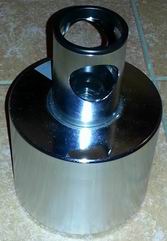A fast and easy, non-destructive test (NDT) method of estimating the cylinder compressive strength is by the use of a Schmidt Hammer.
The Schmidt Hammer impacts on the concrete surface which causes the hammer to rebound giving a rebound number. This method is also known as the rebound hammer method for this reason.
With the help of conversion charts and the knowledge of an experienced technician familiar with the limitations of the Schmidt Hammer, an estimated cylinder compressive strength can be determined.
This strength should always be considered as indicative only especially in older carbonated structures and should be supported by compressive strength testing.







